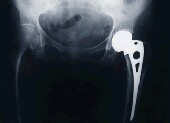
FRIDAY, Feb. 18 (HealthDay News) — Months after getting a ceramic hip replacement, some patients may be startled to find their artificial joint starts squeaking.
Not everyone who gets a ceramic fitting will end up getting one that squeaks, but those who do are likely to be taller, heavier and younger than their silent counterparts, new research shows.
Fortunately, the squeaks are more of a nuisance than a serious problem, stated the authors of a study to be presented at the annual meeting of the American Academy of Orthopaedic Surgeons, Feb. 15 to 19 in San Diego.
Other experts agree.
“Although it’s disconcerting to have noise coming from a hip replacement, there is no significant implication as far as either the quality of the relief from the hip replacement or in terms of its longevity or any other objective measure that would indicate that the squeaking has a deleterious effect,” said Dr. Michael Bronson, chief of joint replacement surgery at Mount Sinai Medical Center in New York City.
Dr. Craig Della Valle, associate professor of orthopedic surgery at Rush University Medical Center in Chicago, added: “I don’t think there’s any data to show that squeaking is harmful to patients. It doesn’t seem to have any real consequences.”
That said, the noise could indicate that “the bearing surface isn’t performing quite the way it should,” Della Valle said. “Most of the data seems to indicate that [the squeaking results from] abnormal wear on the bearing surface, and that leads to loss of normal lubrication and that leads to noise.”
Three major surfaces are used for hip replacements — metal-on-plastic, ceramic-on-ceramic and metal-on-metal, said Della Valle.
“All of them have pros and cons and it remains controversial which is the best and for which patients,” he said. “Metal-on-[plastic] is kind of the standard and the plastic has changed over time to become more wear -resistant, but historically the big problem with plastic is it wears, hence the interest in ‘hard bearings’ [such as ceramic] that are more wear-resistant.”
The researchers reviewed records on 2,406 hip replacements involving ceramic-on-ceramic bearings that they performed at Mater Hospital in Sydney, Australia, between June 1997 and December 2008. All patients had had osteoarthritis.
The authors identified 74 squeaking hips in 73 patients (some people have both hips replaced), representing 3.1 percent of the group.
Patients with squeaky hips were likely to be a little bit taller: a mean height of about 5 feet 7 inches compared to 5 feet 6 inches. They were also heavier (176.8 pounds versus 168.4 pounds) and younger (average age of 60 versus 65). And, they were significantly more active, all of which suggest the noise is caused by increased mechanical demands, the authors said.
Obesity was not associated with squeaking, the authors said.
Average time to when the squeaking first began was 14 months after the operation. Only 5 percent of patients reported squeaking each time they took a step, and 63 percent said their new hip made noise less than once a day.
Bending caused joints to squeak more than walking, stair climbing or participating in sports, the authors found.
Some people do have a second operation to silence their artificial hip said Della Valle. Another surgery isn’t ideal, but a patient might consider it if the joint “squeaks with every step they take,” he said.
Experts note that research presented at meetings has not been subjected to the same type of rigorous scrutiny given to research published in peer-reviewed medical journals.
More information
The American Academy of Orthopaedic Surgeons has more on joint replacement surgery.

